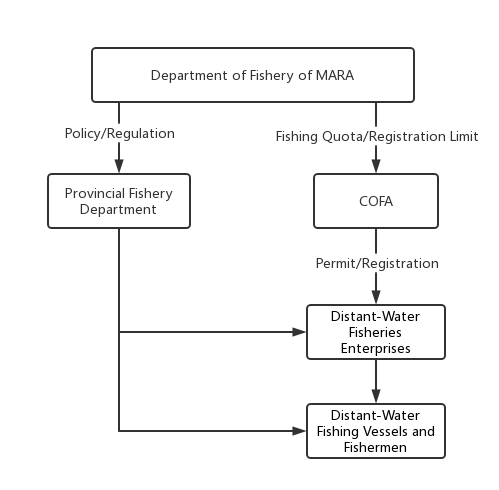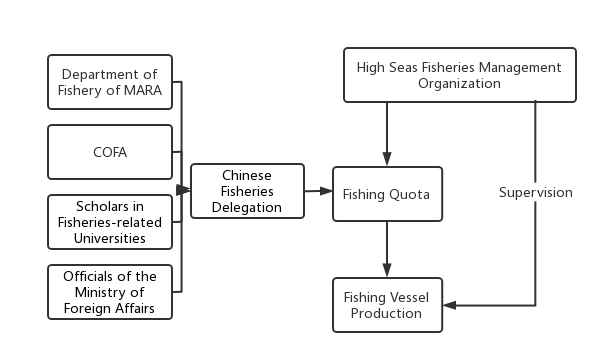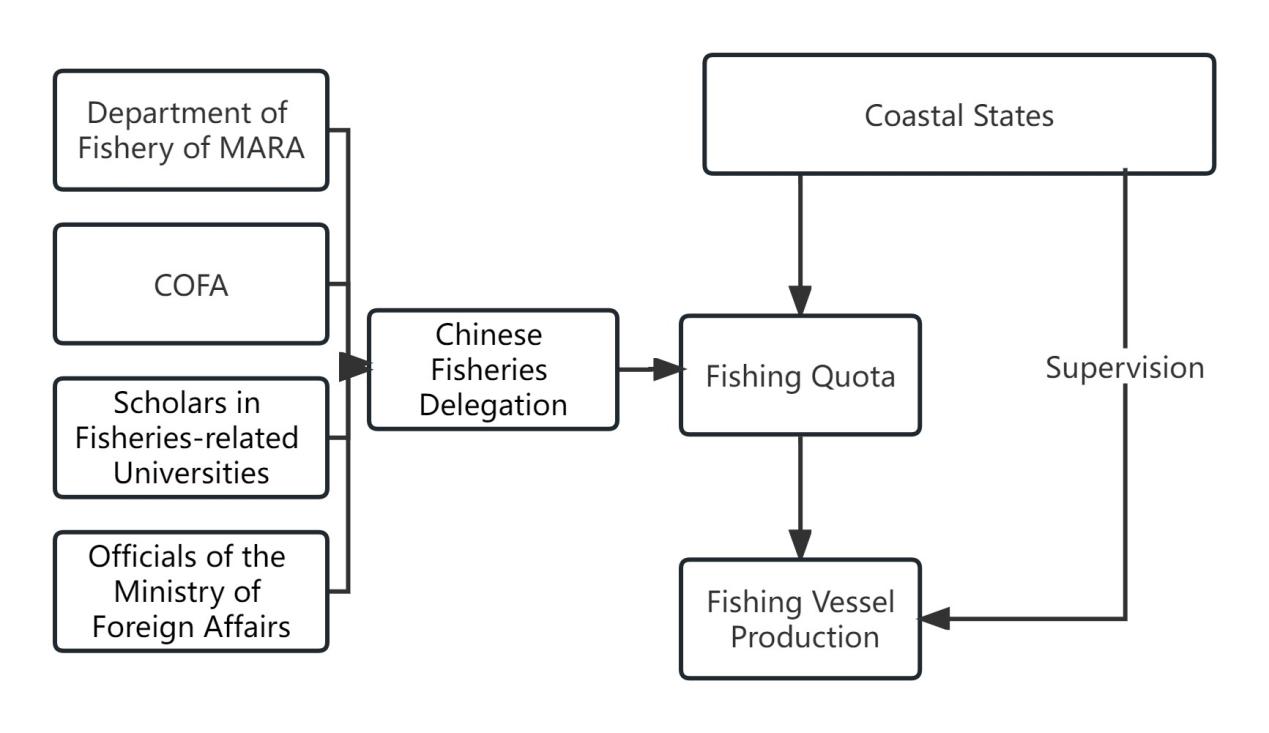1. Introduction
Distant-water fisheries constitute a significant component of China’s blue economy. By the end of 2019, China had 178 legally registered distant-water fisheries enterprises and 2,701 approved distant-water fishing vessels, including 1,589 operating in international waters. These vessels operate in the Pacific, Indian, Atlantic Oceans, the high seas, the Antarctic Ocean, and the jurisdictional waters of cooperating countries [1]. In 2022, China’s distant-water fisheries production reached 2.3298 million tons, marking a 3.71% year-on-year increase and accounting for 3.39% of the total aquatic product output. The ocean fishing industry’s total value was CNY 248.891 billion, constituting 8.06% of China’s overall fisheries economy [2].
Apart from its economic significance in China’s national economy, distant-water fisheries are closely related to national strategies such as “Maritime Power” and the “Belt and Road Initiative” proposed by Chinese leadership in recent years. Consequently, they have garnered substantial attention from academia and the government. Simultaneously, China’s distant-water fisheries face various challenges, including declining production and value, reductions in the number of fishermen and affiliated enterprises, and safety hazards in the fishing process. These issues require the active participation of relevant stakeholders. This paper focuses on the primary participants in the management of China’s distant-water fisheries, investigates the roles played by these participants in China’s distant-water fisheries management, and discusses how these stakeholders can further enhance the management level of China’s distant-water fisheries, promoting sustainable and efficient development.
2. Current Status of Participants in China’s Distant-Water Fisheries Management
China’s distant-water fisheries, due to their operations in international waters, possess unique characteristics. The development and activities of this industry are subject to strict regulation not only by China’s domestic fisheries authorities but also by regional and international fisheries-related organizations. The following sections will outline the domestic and international participants in the management of China’s distant-water fisheries.
2.1. Domestic Participants in China’s Distant-Water Fisheries Management
In China, various levels of domestic participants are interconnected in a top-down manner in the management of distant-water fisheries. The primary domestic participants include the Ministry of Agriculture and Rural Affairs’ Fisheries and Fishery Law Enforcement Bureau, local fisheries and fishery law enforcement bureaus, the Ministry of Foreign Affairs and its embassies and consulates abroad, the China Distant-Water Fisheries Association, fisheries enterprises, and various marine and fisheries-related universities.
The Fisheries and Fishery Law Enforcement Bureau of the Ministry of Agriculture and Rural Affairs is the highest governmental authority directly responsible for nationwide fisheries management. Its responsibilities span the entirety of China’s fisheries sector. Its division for distant-water fisheries is the leading department responsible for managing distant-water fisheries, shaping policies, and making decisions. When the distant-water fisheries sector in China needs to negotiate or communicate with international or regional fisheries management organizations, the Fisheries and Fishery Law Enforcement Bureau serves as the chief representative of China’s fisheries sector in international dialogues.
Local fisheries and fishery law enforcement bureaus mainly comprise provincial and municipal-level fishery management authorities along China’s coastal provinces. These local bureaus are primarily responsible for overseeing and regulating the production processes of businesses and fishing vessels. They possess law enforcement powers and are in charge of various aspects, including catch management, vessel registration, and ensuring the welfare of fishermen on local distant-water fishing vessels. The specific responsibilities and scope depend on the scale of the distant-water fisheries industry in the respective regions. Provinces such as Fujian, Zhejiang, and Shandong, with well-developed distant-water fisheries, place greater pressure on their local fisheries and fishery law enforcement bureaus. Furthermore, these local bureaus also host international fisheries management organization representatives when they visit for inspection, making them fundamental grassroots participants in the management of China’s distant-water fisheries.
The Ministry of Foreign Affairs and its embassies and consulates play an equally significant role in China’s distant-water fisheries management. This is because the Chinese government has defined distant-water fisheries as an industry with international influence, and the concept of “fishing rights are maritime rights” is widely accepted among Chinese fisheries management personnel. Thus, distant-water fisheries are directly linked to national interests, necessitating the involvement of staff from the Ministry of Foreign Affairs in handling related matters. Whenever the Chinese government is required to participate in regional fisheries negotiations or when distant-water fishing vessels encounter difficulties in foreign operations, officials from the corresponding regional embassies or consulates often participate, acting as members of working groups to safeguard China’s distant-water fisheries interests.
The China Distant-Water Fisheries Association serves as a mediator between different levels of management in distant-water fisheries. Originally, its role was that of an industry association overseeing the production and operations of businesses within the sector. However, as China’s distant-water fisheries implement a system of fishing licenses, many aspects of vessel operation and fishing permits are approved and issued by the China Distant-Water Fisheries Association. Simultaneously, a significant portion of management regulations from the fisheries and fishery law enforcement bureaus is disseminated to fisheries enterprises through the association. The China Distant-Water Fisheries Association also engages in some international affairs related to distant-water fisheries, including participation in regional fisheries resource negotiations and regional fisheries management organization meetings.
Fisheries enterprises are the immediate stakeholders in China’s distant-water fisheries management. Due to the unique nature of distant-water fisheries in China, all distant-water fishing vessels are operated by businesses, and there are no independently owned distant-water fishing vessels. These businesses are responsible for supervising and managing the fishing locations, catch species, and catch quantities of their respective vessels. Additionally, various problems faced by distant-water fishing vessels are reported to businesses, which, in turn, handle these issues or report them to higher-level regulatory authorities. When a vessel operated by a business engages in illegal or non-compliant activities, the vessel’s captain and crew are penalized, and punitive measures are imposed on the fisheries enterprise. As such, fisheries enterprises prioritize the legality and safety of fishing operations and periodically invite fisheries experts to educate fishermen on the basics of fisheries management. It can be said that fisheries enterprises form the foundational units of China’s distant-water fisheries management. They are both the primary beneficiaries of fisheries management policies and the most rigorously monitored participants in fisheries management.
3. Foreign Participants in China’s Distant-Water Fisheries Management
Foreign participants in the management of China’s distant-water fisheries include various regional fisheries organizations and certain developed fisheries countries. As of the end of 2020, China had become a member of several regional fisheries management organizations (RFMOs), including the International Commission for the Conservation of Atlantic Tunas (ICCAT), the Indian Ocean Tuna Commission (IOTC), the Western and Central Pacific Fisheries Commission (WCPFC), the Inter-American Tropical Tuna Commission (IATTC), the North Pacific Fisheries Commission (NPFC), the South Pacific Regional Fisheries Management Organization (SPRFMO), the South Indian Ocean Fisheries Agreement (SIOFA), and the Commission for the Conservation of Antarctic Marine Living Resources (CCAMLR), fulfilling its obligations as a member according to the requirements of these RFMOs [3].
Simultaneously, China actively participates in multilateral fisheries affairs with organizations such as the United Nations and the Food and Agriculture Organization (FAO) of the United Nations. It also engages in discussions on fisheries-related matters with international organizations such as the Convention on International Trade in Endangered Species of Wild Fauna and Flora (CITES) and the World Trade Organization (WTO). China comprehensively participates in the affairs of relevant regional fisheries management organizations [3].
Furthermore, China actively communicates and exchanges information with international non-governmental organizations involved in regional fisheries management, acquiring fisheries data and information provided by these non-governmental organizations. Some international non-governmental organizations have close ties with the China Distant-Water Fisheries Association, and both parties exchange experiences and opinions in data, information, and research findings when compiling various reports on China’s fisheries industry. Some international non-governmental organizations also offer recommendations for the development of China’s fisheries industry and assist Chinese fisheries authorities in collaborating with fisheries departments of other countries, making them important external supporters in participating in the management of China’s distant-water fisheries.
Certain developed fisheries countries, including Australia and the United States, dispatch fisheries observers to enter fisheries organizations or send their own offshore law enforcement vessels to patrol areas where some Chinese distant-water fishing vessels operate, ostensibly under the pretext of “assisting other countries in sustainable fisheries resource management.” They conduct boarding inspections on some of China’s distant-water fishing vessels [4]. This action has both positive and negative aspects for China’s distant-water fisheries. On one hand, the presence of these fisheries observers further emphasizes the necessity for Chinese distant-water fishermen to conduct their operations legally and in compliance with regulations, keeping them vigilant to avoid severe consequences. On the other hand, these developed fisheries countries often harbor hostile attitudes toward China’s fisheries development. They aggressively promote false information about illegal fishing and malicious development by China in international publicity. Their annual fisheries reports frequently contain deliberate smears against China, and in some cases, they incite resource-rich but underdeveloped countries to resist the operations of Chinese distant-water fishing vessels, which has a detrimental impact on the development of China’s distant-water fisheries [5].
In summary, foreign participants in China’s distant-water fisheries management do not engage in such activities voluntarily or with the intent to assist China’s fisheries development. Their involvement is driven more by their self-interest and concerns that China’s distant-water fisheries may harm their own interests.
4. Cooperation among Participants in China’s Distant-Water Fisheries Management
In the realm of China’s distant-water fisheries management, various participants collaborate based on the division of domestic and international distant-water fisheries management affairs. Domestically, the roles and responsibilities are as illustrated in Figure 1. The Fisheries and Fishery Law Enforcement Bureau, a subsidiary of the Ministry of Agriculture and Rural Affairs(MARA), serves as the central governing body. It directly manages the production operations of fishing vessels through local fisheries and fishery law enforcement bureaus. Meanwhile, the China Distant-Water Fisheries Association functions as the coordinating management department for distant-water fisheries enterprises. It is responsible for issuing production permits to these enterprises, as well as vessel registration and other related matters. Local fisheries and fishery law enforcement bureaus, as the department overseeing the development of the local distant-water fisheries industry, ensure real-time supervision of the legal and compliant operations of fishing vessels within their jurisdictions. They also conduct regular knowledge and safety training for fishermen involved in distant-water fisheries.

Figure 1. Domestic Structure of China’s Distant-Water Fisheries Management
The management of China’s distant-water fisheries on the international front differs significantly from the domestic framework. It involves numerous management participants, and conflicts of interest may arise among these stakeholders. Based on the different operational areas of China’s distant-water fisheries, it can be divided into two major components: high seas and regional fisheries management structures, as depicted in Figure 2.

Figure 2. Structure of China’s Distant-Water Fisheries Management in the High Seas
China’s negotiations concerning distant-water fisheries resources are conducted by the Chinese fisheries delegation. This delegation can be further divided into negotiation officers and experts. High-ranking fisheries officials, such as the Deputy Director of the Fisheries and Fishery Law Enforcement Bureau and the Deputy Director of the Ministry of Foreign Affairs, serve as negotiation officers, responsible for professional negotiations. Experts from universities and associations function as an advisory team, translating research findings and relevant data into negotiation materials for the officers. They also analyze data from other participating nations involved in fishery negotiations. This includes records of fisheries agreements, legal catch records, and fisheries management assistance records, which are summarized into reports for the reference of negotiation officers.
The second part of China’s distant-water fisheries management concerns fisheries within the exclusive economic zones of coastal nations with abundant fisheries resources. In this context, the primary regulatory body becomes the fisheries management authority of the coastal nation. The management structure for these regions is akin to that of the high seas distant-water fisheries management. Negotiations on the allocation of fisheries resources are required, and China’s distant-water fishing vessels must legally operate under the supervision of the coastal nation’s fisheries management authority [6].

Figure 3. Structure of China’s Distant-Water Fisheries Management in the Exclusive Economic Zones of Coastal States
5. Challenges and Prospects in Research
One of the central aspects of distant-water fisheries management is the acquisition of fisheries resources. Constrained by treaties related to exclusive economic zones and other provisions in the United Nations Convention on the Law of the Sea, the vast majority of fisheries resources available for development by China’s distant-water fisheries are located in the coastal areas of other countries. Consequently, these fisheries resources are susceptible to constraints imposed by China’s relations with coastal nations. To pursue the development of these resources, distant-water enterprises necessarily rely on state-level coordination to facilitate communication between China and countries with abundant fisheries resources. However, as international circumstances evolve and external factors come into play, China encounters numerous obstacles in its communication with countries possessing rich fisheries resources. Being a traditional continental nation, China has a relatively short history of engagement with island and archipelagic nations, and it has not yet established a deep and stable mutual trust mechanism. Therefore, China’s distant-water fisheries management faces various challenges.
In response to these challenges, China’s distant-water fisheries industry is exploring a new path of international cooperation. This path involves promoting communication and exchange between Chinese distant-water fisheries enterprises and international fisheries-related companies through internationalized industrial cooperation. By focusing on industrial and academic collaboration, the goal is to establish close international relationships in distant-water fisheries. This approach serves to bypass the intricate and complex international political stage on one hand and, on the other hand, to share China’s relevant experiences in distant-water fisheries management. It aims to facilitate the development of the fisheries management capacity of coastal nations and enhance the development of fisheries resources in those countries. Through international cooperation, these objectives can be achieved by jointly developing fisheries resources.
6. Conclusion
From the preceding research, it is evident that the primary actors in China’s distant-water fisheries management are predominantly government agencies and international organizations. The authority of fisheries enterprises is relatively limited, and they largely rely on the leadership of government agencies and industry organizations. However, with the changing international landscape and the gradual intensification of international politics, governments of various countries have had to abandon dialogue due to significant differences in interests and political disagreements. This development undoubtedly poses a significant challenge for distant-water fisheries reliant on government management.
Therefore, the managers of China’s distant-water fisheries are focusing on enhancing the role of distant-water fisheries enterprises in fisheries management as a crucial development direction. They are attempting to circumvent significant geopolitical and international interest barriers by using industrial exchanges as a link for international fisheries communication. This approach aims to promote the sustainable development of China’s distant-water fisheries management. To achieve this goal, the Chinese distant-water fisheries industry is collaborating with the Chinese government.
Firstly, during the organization of international forums for agricultural and fisheries exchange, arrangements are made for communication and exchange between Chinese distant-water fisheries enterprises and foreign fisheries-related enterprises. Secondly, fisheries management departments are collaborating with the Ministry of Foreign Affairs to support the establishment of offices by Chinese distant-water fisheries enterprises overseas and to recruit foreign employees. Finally, there is an active exploration of the establishment of non-governmental fisheries organizations in China and the promotion of the creation of non-governmental organizations for international fisheries industry cooperation. These measures have yielded significant results. On the one hand, the legitimate and compliant operations of Chinese distant-water fisheries enterprises overseas have effectively countered the malicious smear campaigns in foreign media. On the other hand, the new approach of promoting fisheries industry cooperation has gained unanimous approval from fisheries resource-rich nations. Countries are looking forward to collaborating with China to enhance fisheries management standards and advance the healthy and sustainable development of fisheries.
References
[1]. National Fisheries Economic Statistics Report for 2022. (2023). China Aquatic Products, 08, 7-8.
[2]. National Fisheries Economic Statistics Report for 2021. (2022). Fisheries Science and Technology Information, 49(05), 313.
[3]. Anonymous. (2020). White Paper on China’s Distant Water Fisheries Performance. Ministry of Agriculture and Rural Affairs of the People’s Republic of China Bulletin.
[4]. Nie, Q. (2023, October 13). Research on China’s Distant Water Fisheries Management Policies (Doctoral dissertation). Shanghai Ocean University. DOI:10.7666/d.y1946935.
[5]. Chen, Y., & Nie, Q. (2023, October 13). China’s Distant Water Fisheries Management Development Report.
[6]. Wang, H. (2022). Current Situation, Challenges, and Countermeasures of China’s Distant Water Fisheries Development. Fisheries Science and Technology Information, 49(6), 6.
Cite this article
Tong,H. (2024). Research on participants in China's distant-water fisheries management. Applied and Computational Engineering,60,49-55.
Data availability
The datasets used and/or analyzed during the current study will be available from the authors upon reasonable request.
Disclaimer/Publisher's Note
The statements, opinions and data contained in all publications are solely those of the individual author(s) and contributor(s) and not of EWA Publishing and/or the editor(s). EWA Publishing and/or the editor(s) disclaim responsibility for any injury to people or property resulting from any ideas, methods, instructions or products referred to in the content.
About volume
Volume title: Proceedings of the 4th International Conference on Materials Chemistry and Environmental Engineering
© 2024 by the author(s). Licensee EWA Publishing, Oxford, UK. This article is an open access article distributed under the terms and
conditions of the Creative Commons Attribution (CC BY) license. Authors who
publish this series agree to the following terms:
1. Authors retain copyright and grant the series right of first publication with the work simultaneously licensed under a Creative Commons
Attribution License that allows others to share the work with an acknowledgment of the work's authorship and initial publication in this
series.
2. Authors are able to enter into separate, additional contractual arrangements for the non-exclusive distribution of the series's published
version of the work (e.g., post it to an institutional repository or publish it in a book), with an acknowledgment of its initial
publication in this series.
3. Authors are permitted and encouraged to post their work online (e.g., in institutional repositories or on their website) prior to and
during the submission process, as it can lead to productive exchanges, as well as earlier and greater citation of published work (See
Open access policy for details).
References
[1]. National Fisheries Economic Statistics Report for 2022. (2023). China Aquatic Products, 08, 7-8.
[2]. National Fisheries Economic Statistics Report for 2021. (2022). Fisheries Science and Technology Information, 49(05), 313.
[3]. Anonymous. (2020). White Paper on China’s Distant Water Fisheries Performance. Ministry of Agriculture and Rural Affairs of the People’s Republic of China Bulletin.
[4]. Nie, Q. (2023, October 13). Research on China’s Distant Water Fisheries Management Policies (Doctoral dissertation). Shanghai Ocean University. DOI:10.7666/d.y1946935.
[5]. Chen, Y., & Nie, Q. (2023, October 13). China’s Distant Water Fisheries Management Development Report.
[6]. Wang, H. (2022). Current Situation, Challenges, and Countermeasures of China’s Distant Water Fisheries Development. Fisheries Science and Technology Information, 49(6), 6.









